Accepted Scientific Name: Gymnocalycium stenopleurum F.Ritter
Kakteen Südamerika 1: 265 (266), figs. 1979
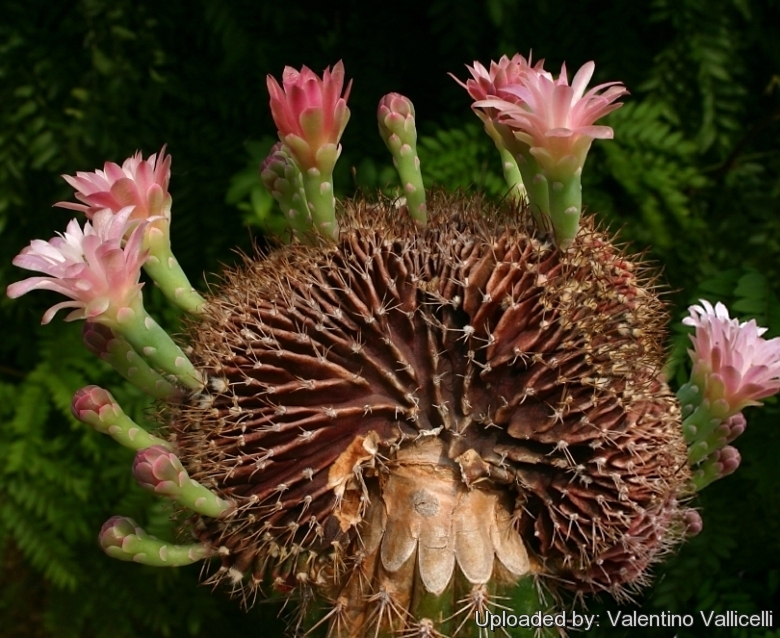
Gymnocalycium friedrichii f. cristatum Photo by: Valentino Vallicelli
Origin and Habitat: Garden origin (Nursery produced cultivar)
Synonyms:
See all synonyms of Gymnocalycium stenopleurum
back
Accepted name in llifle Database:Gymnocalycium stenopleurum F.RitterKakteen Südamerika 1: 265 (266), figs. 1979Synonymy: 7
back
Description: Gymnocalycium friedrichii f. cristatum (crested form), deviate from the standard species for the stem which is fan shaped up to 30 cm (or more) long with age.
The typical Gymnocalycium friedrichii is among the most famous of all cacti for is unique shaped stem and pink flowers.
Habit: Gymnocalycium friedrichii (Gymnocalycium stenopleurum) is a small solitary cacti with banded body sometimes combined with Gymnocalycium mihanovichiiSN|11931]]SN|11929]], and sometimes kept as a separate species.
Stem: Flattened globose to elongated globose, grey green, olive green, greenish-purple, reddish brown to a dark grape colour 10-12 cm tall (or more), 6-12 cm in diameter.
Ribs: 8-14, very prominent, and sharp banded whit strong dark brown markings especially when young, and these sometimes have crossbands of lighter colors.
Radial spines: 3-6, acicular, to awl shaped, light to dark brown, somewhat twisted, 0,7-4 cm long.
Central spines: Usually absent.
Flowers: Pale-pink to purplish-pink, 6-7 cm long.
Fruit: Gray-green up to 4 cm long, diameter 1 cm.
Remarks: Gymnocalycium friedrichiiSN|11932]]SN|11932]] and Gymnocalycium stenopleurumSN|11929]]SN|11931]] are sometimes combined with Gymnocalycium mihanovichii, and sometimes kept as separate species. Gymnocalycium friedrichii and Gymnocalycium stenopleurum are quite distinct from Gymnocalycium mihanovichii, but many intermediate forms are also known and nowadays it is suggested that all should be combined into only one variable species.
Subspecies, varieties, forms and cultivars of plants belonging to the Gymnocalycium mihanovichii/stenopleurum group
The name Gymnocalycium mihanovichii v. friedrichii was introduced by Werdermann in 1936. Pazout suggested the name G. friedrichii nom. inval. in 1964 but it has not been officially approved. In 1979 Ritter made a description of Gymnocalycium stenopleurum that sometimes can be found under the incorrect name G. mihanovichii v. stenopleurum n. n. (don't confuse it with v. stenogonum). Thus we have 3 taxa: "mihanovichii", "friedrichii" and "stenopleurum". Not taking into account their taxonomic definition they are basic points of the complex with many transitional forms between. These three taxa spread from south to north (North-Western Paraguay): The typical "mihanovichii" inhabits the very south of the area – south and south-east of province Boqueron; "stenopleurum" inhabits a limited area on the very north – in Cerro Leon region and has characteristic recognizable habitus; for "friedrichii" all the area between two mentioned points is indicated.
 Gymnocalycium friedrichii (Werderm.) Pazout: Distingushed from Gymnocalycium miahanovichii for the prevalently purplish pink, wide open flowers and well-pronounced polymorphism of spines. Besides it has tall slender ribs and roller-shaped prominent thickening around areoles.
Gymnocalycium friedrichii (Werderm.) Pazout: Distingushed from Gymnocalycium miahanovichii for the prevalently purplish pink, wide open flowers and well-pronounced polymorphism of spines. Besides it has tall slender ribs and roller-shaped prominent thickening around areoles. Gymnocalycium friedrichii f. cristatum hort.: Crested form with nice stems reddish brown to dark grape coloured.
Gymnocalycium friedrichii f. cristatum hort.: Crested form with nice stems reddish brown to dark grape coloured. Gymnocalycium friedrichii var. moserianum Pazout ex Moser: has brown bodies 2 times larger than G. friedrichii, with sharp ribs striped with white, and only 3 weak spines. Flowers are pale pink and open up entirely. Distribution: Yrebdaque, Boquerón, Paraguay.
Gymnocalycium friedrichii var. moserianum Pazout ex Moser: has brown bodies 2 times larger than G. friedrichii, with sharp ribs striped with white, and only 3 weak spines. Flowers are pale pink and open up entirely. Distribution: Yrebdaque, Boquerón, Paraguay. Gymnocalycium mihanovichii (Frič ex Gürke) Britton & Rose: It has wider, lower ribs, in juvenile plants divided into separate chins, in maturity every rib have flat surface and a pleat above each areole. But the essential thing is its pale or brownish-yellow, not fully opening flower.
Gymnocalycium mihanovichii (Frič ex Gürke) Britton & Rose: It has wider, lower ribs, in juvenile plants divided into separate chins, in maturity every rib have flat surface and a pleat above each areole. But the essential thing is its pale or brownish-yellow, not fully opening flower. Gymnocalycium mihanovichii var. filadelfiense Backeb.
Gymnocalycium mihanovichii var. filadelfiense Backeb. Gymnocalycium mihanovichii var. stenogonum Frič & Pazout: has larger stem (up to 15 cm in diameter), smooth fresh green to bronze in full sun. The greenish flowers are also larger. Distribution: Toro Alarachii, southern Chaco, Argentina.
Gymnocalycium mihanovichii var. stenogonum Frič & Pazout: has larger stem (up to 15 cm in diameter), smooth fresh green to bronze in full sun. The greenish flowers are also larger. Distribution: Toro Alarachii, southern Chaco, Argentina. Gymnocalycium mihanovichii cv. Hibotan hort.: chlorophylles mutants, characterized by more or less red coloured bodies.
Gymnocalycium mihanovichii cv. Hibotan hort.: chlorophylles mutants, characterized by more or less red coloured bodies. Gymnocalycium mihanovichii cv. Hibotan f. cristata hort.: this is the crested form of the chlorophyll-less cv. Hibotan characterized by more or less red coloured bodies.
Gymnocalycium mihanovichii cv. Hibotan f. cristata hort.: this is the crested form of the chlorophyll-less cv. Hibotan characterized by more or less red coloured bodies. Gymnocalycium mihanovichii cv. Nishikii hort.: variegated cultivars only partially de-coloured.
Gymnocalycium mihanovichii cv. Nishikii hort.: variegated cultivars only partially de-coloured. Gymnocalycium stenopleurum F.Ritter: Distingushed from Gymnocalycium miahanovichii for the white, fully opening flowers. Distribution: Cerro León, Boquerón department of Paraguay.
Gymnocalycium stenopleurum F.Ritter: Distingushed from Gymnocalycium miahanovichii for the white, fully opening flowers. Distribution: Cerro León, Boquerón department of Paraguay.
Bibliography: Major references and further lectures
1) Edward Anderson “The Cactus family” Timber Press, Incorporated, 2001
2) James Cullen, Sabina G. Knees, H. Suzanne Cubey "The European Garden Flora Flowering Plants: A Manual for the Identification of Plants Cultivated in Europe, Both Out-of-Doors and Under Glass" Cambridge University Press, 11/Aug/2011
3) David R Hunt; Nigel P Taylor; Graham Charles; International Cactaceae Systematics Group. "The New Cactus Lexicon" dh books, 2006
4) N. L. Britton, J. N. Rose “The Cactaceae. Descriptions and Illustrations of Plants of the Cactus Family.” Volume 4, The Carnegie Institution of Washington, Washington 1923
5) Curt Backeberg “Die Cactaceae: Handbuch der Kakteenkunde” Gustav Fischer Verlag, Stuttgart New York 1982–1985
6) Dmitriy Rogatskin “Controversial point” Cultivar e-magazin ISSUE 3 (25): 4 <http://www.lapshin.org/cultivar/N25/index-e.htm>
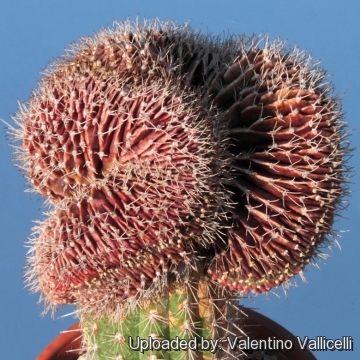 Gymnocalycium friedrichii f. cristatum Photo by: Valentino Vallicelli
Gymnocalycium friedrichii f. cristatum Photo by: Valentino Vallicelli Gymnocalycium friedrichii f. cristatum Photo by: Valentino Vallicelli
Gymnocalycium friedrichii f. cristatum Photo by: Valentino Vallicelli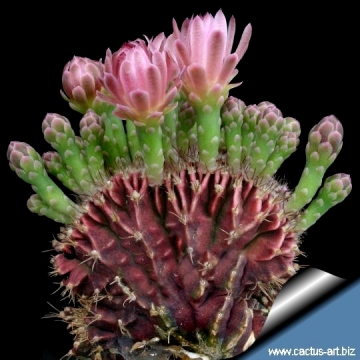 Gymnocalycium friedrichii f. cristatum Photo by: Cactus Art
Gymnocalycium friedrichii f. cristatum Photo by: Cactus Art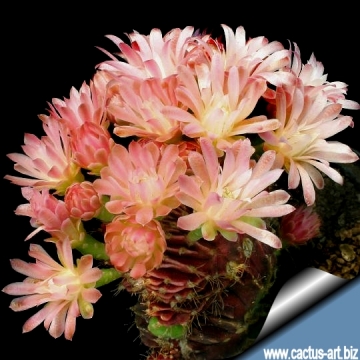 Gymnocalycium friedrichii f. cristatum Photo by: Cactus Art
Gymnocalycium friedrichii f. cristatum Photo by: Cactus Art Gymnocalycium friedrichii f. cristatum Photo by: Valentino Vallicelli
Gymnocalycium friedrichii f. cristatum Photo by: Valentino Vallicelli Gymnocalycium friedrichii f. cristatum Photo by: Valentino Vallicelli
Gymnocalycium friedrichii f. cristatum Photo by: Valentino Vallicelli Gymnocalycium friedrichii f. cristatum Photo by: Cactus Art
Gymnocalycium friedrichii f. cristatum Photo by: Cactus Art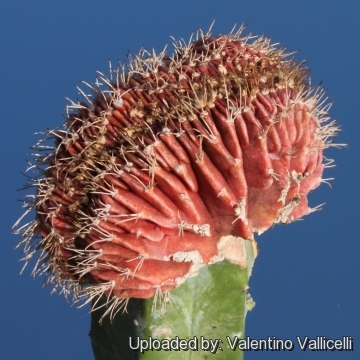 Gymnocalycium friedrichii f. cristatum Photo by: Valentino Vallicelli
Gymnocalycium friedrichii f. cristatum Photo by: Valentino VallicelliCultivation and Propagation: Although regarded as a choice and difficult plant is not too difficult in a greenhouse, although grows quite slowly. It is sometime seen as a grafted plant but grows very well on its own roots too.
Soil: Use mineral well permeable mineral soil with little organic matter (peat, humus).
Exposure: Light shade to half shade. Full sun helps to keep the plants healthy, although slow growth.
Watering: Water sparingly from March till October (weekly during summertime, if the weather is sunny enough), with a little fertilizer added. Less or no water during cold winter months, or when night temperatures remain below 10° to prevent root loss. It is sensitive to overwatering (rot prone).
Fertilization: Feeding may not be necessary at all if the compost is fresh then, feed in summer only if the plant hasn't been repotted recently. Do not feed the plants from September onwards as this can cause lush growth which can be fatal during the darker cold months.
Hardiness: Keep perfectly dry in winter at temperatures from 5 to 15 degrees centigrade. (but it is relatively cold resistant and hardy to -5° C, or possibly colder for short periods) In the rest period no high atmospheric humidity!! (Temperature Zone: USDA 9-11)
Crested growth: Unlike 'monstrose' varieties of plants, where the variation from normal growth is due to genetic mutation, crested growth can occur on normal plants. Sometimes it's due to variances in light intensity, or damage, but generally the causes are unknown. A crested plant may have some areas growing normally, and a cresting plant that looks like a brain, may revert to normal growth for no apparent reason. If you have any of the crested part left you need to remove the normal growth and leave the crested part behind this will need to be done regularly.
Propagation: Crested and variegates cultivars are propagated by graft. Plants are usually grafted onto column-shaped cacti but proved to be able to produce their own roots if degrafted. Cuttings will take root in a minimum temperature of 20° C (but better in hot weather). Cuttings of healthy shoots can be taken in the spring and summer. Cut the stem with a sharp, sterile knife, leave the cutting in a warm, dry place for a week or weeks (depending on how thick the cutting is) until a callus forms over the wound. Once the callus forms, the cutting may be inserted in a container filled with firmed cactus potting mix topped with a surface layer of coarse grit. They should be placed in the coarse grit only; this prevents the cut end from becoming too wet and allows the roots to penetrate the rich compost underneath. Large crested piece must be placed on the soil surface without burying the plant base down in the soil. The application of both a rooting hormone as well as fungicide on the cut surfaces helps prevent infection and accelerate rooting.
Your Photos

by Cactus Art




















